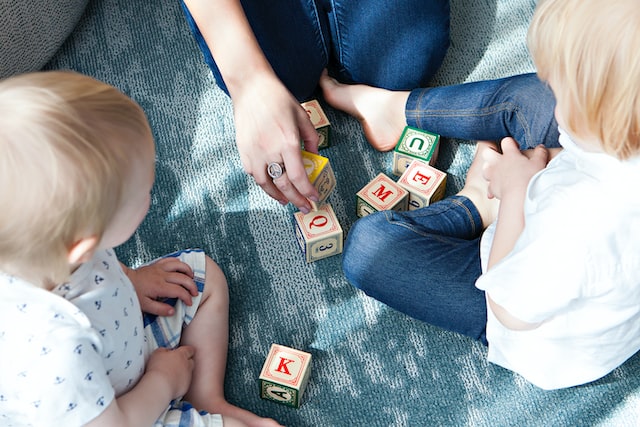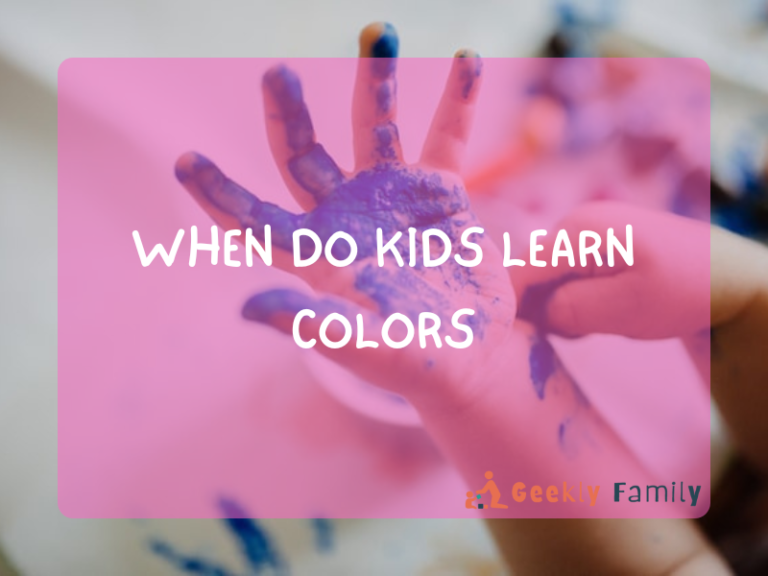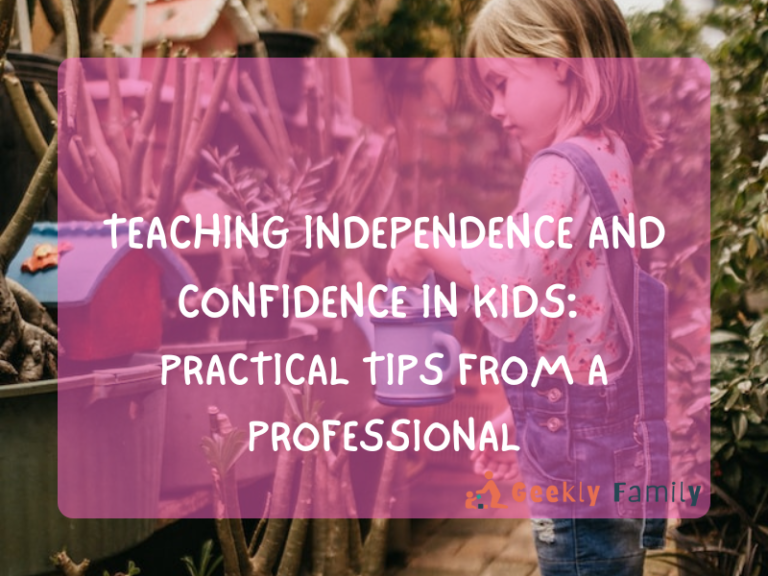When Do Kids Learn to Count? Teaching Counting to Your Child and Math Milestones
As with pretty much everything, we as parents tend to worry if our toddler seems behind with essential skills such as speaking, reading, recognizing colors, and of course, counting. This is because the period between the ages 2 and 4 is the crucial one for setting the foundations of your child’s skills. However, as you also probably know that every child is different and learns things at different pace and with different aptitude.
So, in this article, I explain when do kids learn to count, why it’s important to help them learn and how to teach them in a fun and creative way.

Table of Contents
When Do Kids Learn to Count?
The learning milestones for kids are as follows:
0-12 Months (Babies)
At 0 to 12 months, babies start to understand some basic cause and effect relations. They also distinguish relative sizes such as big and small, notice differences in colors, and can predict sequences of (some) events. For example, if babies see food in front of them they’ll react appropriately depending on whether they like it or not. However, they’ll understand that they are going to be fed.
1-3 Years (Toddlers)
After their first year, babies become toddlers and they start learning at an incredible pace, so many parents start to question “when do kids learn colors?“, when do kids learn to count? ” and so on. One of the secrets to raising smart kids is to introduce counting and reading as early as possible. Of course, this means to start with basic concepts such as pointing out numbers, singing songs about numbers, etc. If you practice regularly through games and fun activities, you’ll notice that by the age of 3, your toddler will be capable of counting up to 10 (or even more) but may mix up the order of the numbers.
3-4 Years (Preschoolers)
At 3 or 4.5 years old, children already recognize shapes, sizes and colors and can therefore sort or group them based on similarities. They can also tackle more abstract concepts and can easily make the connection between the numerals and the number names such as 3 and three. Most of the children will also be able to count to 20 or more.
At this age, preschoolers can start learning how to count by playing with numbers, learning about the number system, and practicing with drills and activities. They learn the words for the numbers and start putting them in order.
5-6 Years (Kindergartners)
With proper guidance in the previous two stages, children will be able to do some basic addition and subtraction at the age of 5 and 6. They may still use their fingers but that’s natural. With more practice they’ll overcome this in no time. Besides counting, adding and subtracting, at the age of 5 and 6, kids in general can also draw symmetrical shapes, follow some basic instructions, and either read or narrate a story without losing track if interrupted.
I remember that my father taught me the alphabet when I was 5 and after enough practice I started grasping the concept of reading. By the time I started school, I was one of the few kids that already knew how to read.
6-7 Years (First and Second Graders)
Once kids start going to school, learn new things and interact, they also begin understanding how things are interrelated. So, at this age, children can distinguish between 2D and 3D, count to 100 by ones, twos, fives, and tens, write and understand numerals from 0 to 100, write and recognize the words for numbers from one to twenty and do some basic addition and subtraction.
Second grade is also the time when kids start tackling into multiplication before they learn division in the third grade. So, regardless of how much you’ve worked with your child previously, starting school is still tough, so make sure to provide additional assistance to your child.
8-9 Years (Third Graders)
By the ages of 8 and 9, most of the children should know:
- addition and subtraction
- multiplication and division
- solve some math problems and
- how to handle money on their own
You can start teaching counting and financial responsibility even before the age of 8 by setting allowance to your kids.
Why Is It Important for Kids to Learn How to Count?
Counting is an important skill for kids as it primarily teaches them to decode the world surrounding them. It also helps them develop their cognitive skills. Kids may learn and understand how counting works by singing songs, rote counting, counting and grouping objects, and so on.
Learning to count and learning about numbers is a really complex process which starts with simple basics. Children learn to count when they can say the words in the right order and understand what the numbers represent. Consequently, it usually takes children between 3 and 4.5 years to learn how to count properly.
Why Is It Important for Parents to Help Their Kids Learn to Count?
Although some scientists believe that humans are born with inherent grammar and math skills, still parents need to provide instructions for their children.
How to Teach Counting to Your Child?
Kids learn to count at different ages. So for example, when do toddlers learn to count will depend on the genetic predisposition of the child but on the support they receive from their parents as well. Some kids learn to count by copying what they see around them, while others learn by playing easy board games with their parents. It’s important to teach kids how to count regularly from a young age, so that they understand math concepts more quickly.
Toy Car Race
This game is great for children aged 3+ and the minimum players needed is 2. To play it, you’ll need toy cars, cardboard tiles, and a dice. The goal of the game is to move the (number you want to practice/learn) of tiles from start to finish. Each player will throw the dice and move the tiles according to the number they get. However, to move the last tile, they’ll have to get the exact number they need.
Rocks
This game is to be played outside. You’ll need a few buckets with numbers and an outdoor item written on it. The challenge for your child is to find the correct bucket and fill it with the exact number of things written on it. For example, if you write 7 rocks on one bucket, your child has to find 7 rocks and fill the bucket with them.
Coin Counting Game
My son absolutely loves this one. I keep one big glass where I collect coins and once it gets pretty much filled, I pour the coins on the floor and let him help me count them. He loves sorting through the coins, analyzing them and grouping them according to the numbers written on them.

Magnetic Fishing Game
To play the magnetic fishing game, you’ll need to get the magnetic fishing toy. Have your child and a friend or two of your children play together and compete who will catch more fish at a limited time. At the end count the number of fish caught and announce the winner!
Number Songs
Nursery rhymes about numbers are a cheerful way for children to learn numbers. Let your child listen to the song several times and you can sing it aloud while counting things. Soon your child will follow up, start mimic you and understand the concept.
Additional Tips on Teaching Preschoolers How to Count
Here are some additional tips for you to help you get started on the right track.
1. Start Early
You can start teaching your preschooler to count from an early age by following these tips:
1. Help your preschooler understand the meaning of words like unlikely and possible.
2. Start teaching them basic time concepts, like morning or days of the week.
3. Teach them how to follow multi-step directions that use words like first and next.
You can start teaching your child how to count from an early age by counting with fingers, starting with 6 on the second hand. You can also teach your child to identify numerals up to 20 and learn to use symmetrical shapes. Help your child understand basic time concepts like morning or days of the week, and follow multi-step directions that use words like first and next. Teach your child the meaning of words like unlikely or possible.
2. Keep It Simple
It’s important to keep it simple when teaching your preschooler to count. This means introducing numbers gradually, and avoiding anything that could be confusing or overwhelming. Start with small numbers of objects, and work up to larger quantities as your child becomes more confident. It’s also helpful to use visual aids, such as a number line or a set of numbered flashcards.
Be sure to praise your child’s progress regularly, and count along with them as they practice counting out loud. Once your child has a basic understanding of counting, you can begin to introduce more complex concepts such as skip counting and adding up numbers.
3. Use Maths ‘Language’
You can use maths ‘language’ to teach your preschooler to count in third person by talking to them about subtraction and addition. This will help them start learning these concepts before they actually learn them in school.
You can use maths ‘language’ to teach your child how to count by talking with them about numerical concepts using words such as ‘more’, ‘less’, and ‘equal’. You can also help them learn subtraction and addition by using these words in conversation.
4. Use Your Fingers
To teach your preschooler to count with fingers using easy steps, begin by having them hold up one hand and count the fingers on that hand with the other. Repeat this process with the other hand. Once your child is able to comfortably count both hands, move on to having them hold up both hands and counting all of the fingers together. Finally, challenge your child by having them hold up one hand and counting down from a certain number, such as 10 or 5.
5. Try Board Games
You can play simple board or card games that involve counting squares or moving a counter along to teach your preschooler about numbers and counting. Monopoly is a great game to teach not only finances but also addition, subtraction and order of numbers. Games that involve dice or other objects that need to be counted can be especially helpful in teaching your child how to count.
6. Go on a Numbers Hunt
First, discuss the importance of numbers with your preschooler. Explain that numbers are everywhere and that they are used to count things.
Next, set up a game to help your preschooler learn how to find and identify numbers. You’ll need some printable cards which have numbers on them (peg cards or peas cards). The game starts by having your preschooler match numbers on the printable cards with numbers on the peg cards.
Finally, provide tips for staying on track during the Numbers Hunt. Start by finding three objects around the house or in nature. Once your child has found all three objects, have him or her count them out loud. Repeat this process until your child is able to comfortably count up to 10 objects.
7. Mix Up Your Counting
You can mix up your counting activities with your preschooler by using colorful flash cards and counting games. You can also start by helping your child count from 1 to 3 and gradually progress to higher numbers.
8. Use Songs About Numbers
My son loved these songs and I’m pretty sure that these songs helped the most for him to learn counting to 10. Songs about numbers can be used to teach numerals from 1-20, basic math concepts, and time concepts like morning or day of the week. You can start by singing nursery rhymes that involve numbers and counting, such as “One, Two, Buckle My Shoe” or “Ten in the Bed.”
Songs about numbers can be accompanied by simple graphics or drawings to aid in learning. Some songs may include directions that children need to follow step-by-step. Songs about numbers may also use words like “unlikely” or “possible.”
7. Put Things in Groups
To teach your child how to count, start with simple concepts such as two amounts being the same number when they look similar. Explain that when adding something to an existing set, the result is that you have more than you had at first. Children don’t need to be taught specific rules about addition and subtraction- they can solve problems by reason alone. Later instruction needs to build on earlier foundations. Numbers should be introduced gradually to avoid overwhelming children.
9. Count with LEGOs or Objects from Their Everyday Life
To teach your preschooler to count with LEGOs, you can model what is right or wrong to them. The main goal is for them to get used to making comparisons. You can start by counting the number of LEGO bricks your child has. Then, you can ask them to compare that number with another number, such as the number of fingers on their hand.
Additionally, you can practice by teaching your child to count things in their everyday life, such as how many steps they take or how many crayons they have. As they progress, you can increase the number of items they need to count.

Conclusion
Kids learn to count at different rates, but there are some general milestones that can be used to guide parents and educators. Most kids will start counting around 18 months old, but this can vary depending on the child’s exposure to numbers and their natural abilities. By age 3, most kids will be able to count up to 10 objects. By age 4, they should be able to count up to 20 objects. And by age 5, they should be able to count up to 100 objects. These milestones provide a general guide, but every child is unique and will learn at their own pace.
So basically, kids learn to count at different ages and when they’re exposed to different counting methods (e.g., by rote counting or associating numbers with objects).
FAQs
1. What is the ability to count?
The ability to count is the ability to say numbers in order from memory. This skill starts developing before children can recognize numerals and is just saying a sequence of numbers. So it’s no wonder that around the age of 2, many parents get concerned about “when do kids learn to count”, if they hear their toddler mixing or skipping numbers.
The simplest way to learn this is to start from one and count upwards. Once the child gets the hang of it, they can also count backward and starting from different points. Repetition is the best way to learn this ability. Counting can be incorporated into a child’s daily routine by counting things like groceries or songs. This is a useful skill in business as it helps with tasks such as inventory and keeping track of sales.
2. Can most 2 year-olds count to 10?
When do toddlers learn to count to 10 will depend on many factors. However, most 2 year-olds are capable of counting to 10, but may mix up the order of the numbers. Daily number practice with flash cards and games can help build a strong foundation for number fluency. Start by helping your child count from 1-3 and gradually progress to higher numbers.
3. When should a child be able to count to 5?
Since children start reasoning about numbers, shapes and sizes since infancy, a child in general should be able to count to 5 before the age of 2. They may mix the order or numbers, or skip a number but that’s just normal. With proper guidance from parents, the child will easily overcome this.
4. How can I help my child learn to count?
There are a few different ways you can help your child learn to count. One way is by using flashcards and playing games that focus on numbers. You can also start by helping your child count from 1-3 and then gradually move up to higher numbers. another way is by providing opportunities for your child to practice counting in everyday life situations such as when cooking, setting the table, or during bath time and cleaning the bath toys.
5. What is the perfect time for kids to learn counting?
It’s best for kids to learn counting before they enter kindergarten. This way, they can start to develop certain math milestones early on. For example, at the chanter level, children start to learn how to count and say number words in a sequencing way. At the reciter level, children can easily count up to 5 or beyond. These advanced levels of counting will help prepare kids for more difficult math concepts later on down the road.
6. When should children learn to skip count?
When children are ready, generally around kindergarten, they should learn to skip count by 10s. They can identify the pattern of ones within each new ten and work on accurately counting objects by 1s. As they develop skills recognizing and describing the pattern of repeating ones within each new ten, it becomes easier for them to skip count.
7. When do kids learn to count by 2s, 5s, and 10s?
Most kids learn to count by 2s, 5s, and 10s around the time they start primary school. Rote counting helps teach kids how to count, number order, and learn to use their hands. For example, if a child is asked to rote count by 2s up to 20, they would say “2, 4, 6, 8, 10, 12, 14, 16, 18, 20.” This helps them understand that each number is two times the number before it.
8. Why is it important for kids to learn to count by 2s, 5s, and 10s?
Rote counting by 2s, 5s, and 10s is important for kids because it helps them develop a better understanding of numbers. It also helps them learn how to count efficiently. Counting exercises can be started with things that are easy for children to understand, such as cereal servings. Rote counting is important because it teaches children how to count, number order, and how to count with their hands.
9. How can you teach your child to count by 2s, 5s, and 10s?
One way to teach a child to count by 2s, 5s, and 10s is by making a game out of it. You can use objects around the house to help count, or even fingers. This can be a fun way for toddlers to learn quickly. Another way is to skip count by 2s, 5s, and 10s when doing things like drawing items or counting jelly beans together. It’s important that children learn the number words along with counting so they can more easily understand what they’re doing. Parents can also teach their children how to count by 2s, 5s, 10s through different activities such as grocery shopping or coin counting. It’s beneficial for children to learn arithmetic basics so they can understand instructions during counting exercises. By teaching your child how to count in various ways, you’ll help them develop strong memory skills and faster calculation speeds.
10. What are some fun math games and activities for kids to learn to count by 2s, 5s, and 10s?
You can help your child learn to count by 2s, 5s, and 10s by playing math games with them. These games will also help toddlers learn how to count and increase their arithmetic skills.
– Play a game of memory with your child using cards that have numbers on them. Lay the cards out face down in a grid and take turns flipping them over two at a time. If the two numbers match, remove the cards from the grid. The player with the most matched pairs at the end wins!
– Make a number line with your child using painter’s tape or chalk on the ground outdoors. Write (or have your child write) numbers counting by 2s, 5s, or 10s depending on what they are trying to learn. Then hop or jump along the line as you recite the numbers aloud together.
– Cut out large circles from construction paper and write numbers counting by 2s, 5s, or10s on each one. Hang them up around your house or in your yard and take turns throwing beanbags or small balls at them as you recite the numbers aloud together. For an extra challenge, try to hit specific target areas on each circle!
– Play a game of “I Spy†with your child, but instead of using objects, use numbers. Take turns saying things like “I spy with my little eye something that is five†and see if the other person can guess what you are talking about. You can also do this activity by counting by 2s, 5s, or 10s to make it more challenging.
11. What are some things to keep in mind when teaching your child to count by 2s, 5s, and 10s?
Here are some tips for teaching your child to count by 2s, 5s, and 10s:
– Help them understand that counting by 2s, 5s, and 10s simply means adding those numbers together each time. For example, when counting by 2s starting from 0, the next number would be 2 (0+2), then 4 (2+2), then 6 (4+2), and so on.
– Start with small numbers first and gradually increase the amount as they get better at it. For example, you can start with counting by 2s from 0 to 10, then 20, 30, 40, and so forth.
– Encourage them to use their fingers or other objects to keep track of where they are while counting. This will help them visualize the concept better and keep track of their progress.
– Practice makes perfect! So try to do some counting sessions with your child every day to help them master this skill quickly.
12. What are some common mistakes parents make when teaching their child to count by 2s, 5s, and 10s?
One common mistake parents make when teaching their child to count by 2s, 5s, and 10s is not using teachable moments. Instead, they may make it the focus of playtime which can cause the child to become bored or frustrated. Another mistake is not providing enough variety in counting activities. For example, if a parent only uses stuffed animals to teach counting, the child may become quickly disinterested. It’s important to mix up counting activities and use different objects whenever possible.
13. How can you tell if your child is ready to learn to count by 2s, 5s, and 10s?
If a child can understand that objects differ by counting by 2s, 5s, and 10s, they are likely ready to learn to count. This skills helps them develop a strong foundation in math which will be beneficial for future academic endeavors.






